Taiwan in Time: Oct.19 to Oct. 25
Taiwan is one of a handful countries in the world not a member of the UN, stemming back to Oct. 25, 1971 when UN General Assembly Resolution 2758 was ratified in a two-thirds vote.
The resolution, sponsored by Albania, recognized the People’s Republic of China (PRC) as “the only legitimate representative of China to the United Nations” and expelled “the representatives of Chiang Kai-shek [蔣介石] from the place which they unlawfully occupy at the United Nations and in all the organizations related to it.”
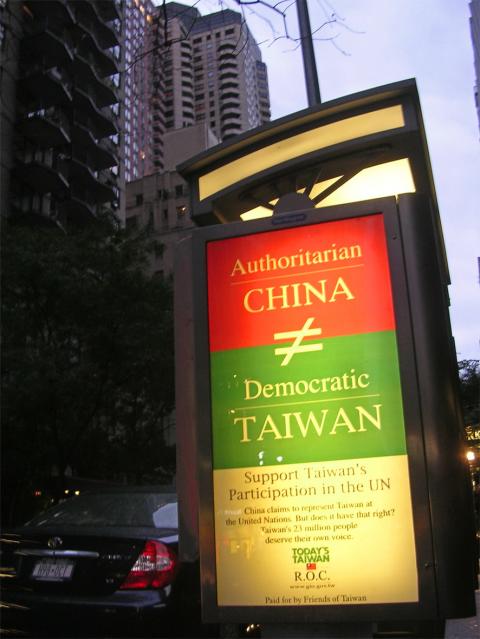
Photo: Wang Pei
The issue was that after the Chinese Civil War, the PRC under the Chinese Communist Party gained control of China, with Chiang’s Republic of China (ROC) government under the Chinese Nationalist Party (KMT) relegated to Taiwan and other minor islands. Yet both governments continued to claim to be the legitimate ruler of both China and Taiwan.
In fact, the ROC was a charter member of the UN, formed also this week, on Oct. 24, 1945, along with the Soviet Union, the UK and the US.
The UN General Assembly debated transferring China’s seat from the ROC to the PRC throughout the 1950s and 1960s, but the US was able to use its influence to block the move.
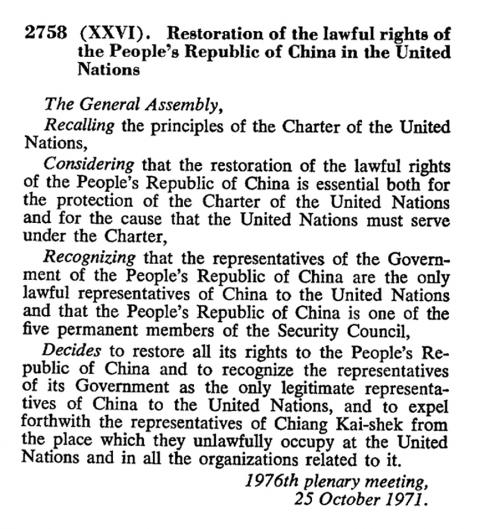
Photo courtesy of Wikimedia Commons
As early as 1950, the UK recognized the PRC as the legitimate government of China, severing relations with the ROC. But things really started changing in the 1960s, as the PRC gained the support of a large number of newly independent nations (mostly in Asia, South America and Africa) that changed the composition of the international body. And in 1964, even France, decided to recognize the PRC.
Starting in 1961, the US and other countries would introduce a resolution every year deeming any proposal to change China’s representation an “important question” that required a two-thirds majority to pass. That resolution would pass every time, but the vote for the subsequent resolution regarding accepting the PRC became increasingly tighter, reaching a tie in 1965.
Canada established ties with the PRC in October 1970. A month later, for the first time a majority supported the PRC’s admission with a 51 to 49 vote — although still not meeting the two-thirds requirement.
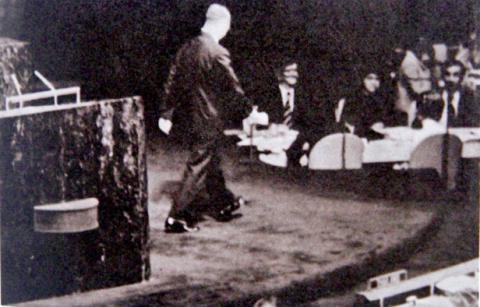
Photo taken from the book ‘The KMT and The ROC’
The US had tried to propose the idea of dual representation by allowing both governments into the UN (with the PRC taking over the Security Council seat) but neither Chiang nor the PRC would likely have agreed to such an idea due to their insistence on being the sole ruler of China and Taiwan.
The US submitted a dual representation resolution in 1971 nonetheless. Albania, however, had already submitted its bid to admit the PRC and it was to be voted on first. If passed, then dual representation would be a moot point. The Americans made one last effort by proposing to remove the “expulsion of Chiang” part from Albania’s resolution, but the motion was rejected.
Before the vote, the ROC delegation announced that they would not take part in further proceedings and walked out of the General Assembly.
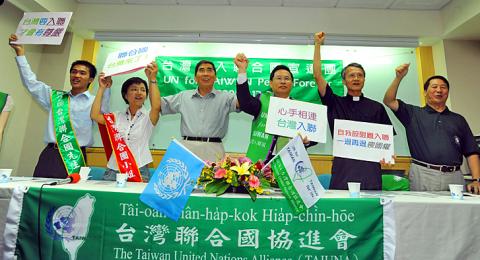
Photo: Wang Yi-sung, Taipei Times
On Oct. 27, Chiang officially declared the ROC’s withdrawal from the UN and its refusal to recognize the resolution.
“The United Nations has set justice aside, shamefully prostrating to evil forces and cowardly yielding to violence,” he wrote. “The United Nations that my country helped form is now a hotbed of evil, and history will prove that the Republic of China’s declaration of withdrawal will also be the declaration of the destruction of the United Nations.”
“My compatriots, the fate of our country is not in the hands of the United Nations, but in our own,” he added.
The resolution never directly mentioned the ROC or Taiwan, but the country’s bid for membership starting in the 1990s under variations of “Republic of China, Taiwan” and in 2007 as “Taiwan.”
It has continuously been rejected largely because of China’s opposition and claim that Taiwan is part of its territory and not a sovereign country.
In 2008, President Ma Ying-jeou (馬英九) stopped applying as part of his “diplomatic truce” policy toward China, but Taiwanese-Americans continue to protest outside the UN Headquarters in New York each year.
Taiwan in Time, a column about Taiwan’s history that is published every Sunday, spotlights important or interesting events around the nation that have anniversaries this week.

Most heroes are remembered for the battles they fought. Taiwan’s Black Bat Squadron is remembered for flying into Chinese airspace 838 times between 1953 and 1967, and for the 148 men whose sacrifice bought the intelligence that kept Taiwan secure. Two-thirds of the squadron died carrying out missions most people wouldn’t learn about for another 40 years. The squadron lost 15 aircraft and 148 crew members over those 14 years, making it the deadliest unit in Taiwan’s military history by casualty rate. They flew at night, often at low altitudes, straight into some of the most heavily defended airspace in Asia.

Beijing’s ironic, abusive tantrums aimed at Japan since Japanese Prime Minister Sanae Takaichi publicly stated that a Taiwan contingency would be an existential crisis for Japan, have revealed for all the world to see that the People’s Republic of China (PRC) lusts after Okinawa. We all owe Takaichi a debt of thanks for getting the PRC to make that public. The PRC and its netizens, taking their cue from the Chinese Communist Party (CCP), are presenting Okinawa by mirroring the claims about Taiwan. Official PRC propaganda organs began to wax lyrical about Okinawa’s “unsettled status” beginning last month. A Global

Taiwan’s democracy is at risk. Be very alarmed. This is not a drill. The current constitutional crisis progressed slowly, then suddenly. Political tensions, partisan hostility and emotions are all running high right when cool heads and calm negotiation are most needed. Oxford defines brinkmanship as: “The art or practice of pursuing a dangerous policy to the limits of safety before stopping, especially in politics.” It says the term comes from a quote from a 1956 Cold War interview with then-American Secretary of State John Foster Dulles, when he said: ‘The ability to get to the verge without getting into the war is
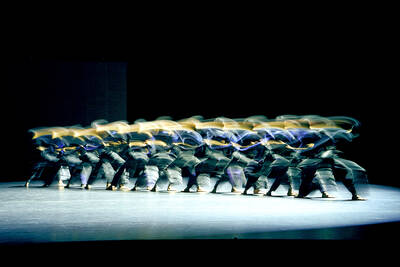
Like much in the world today, theater has experienced major disruptions over the six years since COVID-19. The pandemic, the war in Ukraine and social media have created a new normal of geopolitical and information uncertainty, and the performing arts are not immune to these effects. “Ten years ago people wanted to come to the theater to engage with important issues, but now the Internet allows them to engage with those issues powerfully and immediately,” said Faith Tan, programming director of the Esplanade in Singapore, speaking last week in Japan. “One reaction to unpredictability has been a renewed emphasis on